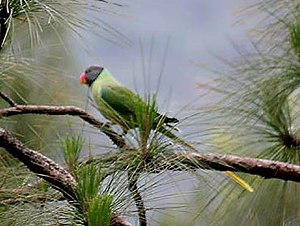Black-headed Parakeet
| Black-headed Parakeet | ||||||||||||
|---|---|---|---|---|---|---|---|---|---|---|---|---|

Black-headed Parakeet ( Psittacula himalayana ), hen |
||||||||||||
| Systematics | ||||||||||||
|
||||||||||||
| Scientific name | ||||||||||||
| Psittacula himalayana | ||||||||||||
| ( Lesson , 1832) |
The black-headed parakeet ( Psittacula himalayana ), also known as the black-headed parakeet , is a species of parrot from the genus of the noble parakeet (Psittacula) that is widespread from eastern Afghanistan via north India to Nepal .
etymology
The name black-headed parakeet comes from the black head of the animal. Initially the animal was also called Himalayan Parakeet. In the German-speaking world, the animal is also known colloquially as the Black-headed Parakeet in order to avoid confusion and to enable breeders to distinguish between species such as the Plum-headed Parakeet or species from the species of the Flat-tailed Parakeet . IG Parakeets of the Association for species conservation, aviculture and bird breeding (AZ) has to avoid confusion, the clear distinction between the Northern Rosella - is what also referred in breeding circles as a slaty-headed parakeet - and the name "Schwarzkopf parakeet" recommended.
distribution
The distribution area of the black-headed parakeet stretches from eastern Afghanistan via northern India to Nepal. In this area it lives in the forests and fields of the Indian subcontinent, and can be found at an altitude of up to 1500 meters.
features
The black-headed parakeet is often confused with the very similar plum-headed parakeet, which only differs in the color on the head. The black-headed parakeet reaches a size of 33–37 cm, of which the tail feathers measure about 20–25 cm. The hens are about 5 cm smaller. The weight of the parakeets is approx. 60 g. The roosters have a black head, which is almost completely absent from the green plumage by the collar. They also have a red patch on their shoulders. The hens differ in their plumage by a gray head with black tints with a clearly visible separation by a black collar. The collar tends to have a bluish frizz on them. The red shoulder mark is completely absent on them. The upper beak is red-orange and the lower beak orange in both sexes.
Reproduction
The breeding season of the black-headed parakeet begins at the end of April and lasts until June. During this time the female is particularly dominant. They are cave-breeders, 3–6 eggs are laid in the nests and the young hatch after about 7 weeks after the second egg has been laid. After hatching, the young spend around two months in the nest. The hen sleeps with the chicks in the nesting box for about 3 more weeks. When the chicks leave the nest, they lose a lot of weight because they do not eat or eat very little for a few days. This is to be as light as possible on the first flight, after the first flight the young are fed for a while by their parents and almost all other adult birds in the flock. The adult birds without young act as godparents for the young birds of the opposite sex.
swell
Individual evidence
- ↑ Hans Strunden: The names of the parrots and parakeets . 1986, p. 49 .
- ↑ Black-headed Parakeet / Psittacula himalayana himalayana. Archived from the original on August 25, 2007 ; accessed on October 24, 2015 .
literature
- Wolfgang de Grahl: Atlas Parrots and Parakeets of the World, Volume 1: Parakeets . Horst Müller, Walsrode 1980, ISBN 3-923269-03-X .
- Dieter Hoppe : Parakeets and parrots . Ulmer, 2007, ISBN 978-3-8001-5566-8 .
Web links
- Psittacula himalayana inthe IUCN Red List of Threatened Species 2015.3. Listed by: BirdLife International, 2012. Retrieved October 27, 2015.
- BirdLife International: Species Factsheet - Slaty-headed Parakeet ( Psittacula himalayana ) . Retrieved October 27, 2015.
- Videos, photos and sound recordings of Slaty-headed Parakeet (Psittacula himalayana) in the Internet Bird Collection
- Black-headed Parakeet ( Psittacula himalayana ) at Avibase; accessed on October 27, 2015.
- Psittacula himalayana in the Integrated Taxonomic Information System (ITIS). Retrieved October 27, 2015.
- xeno-canto: Sound recordings - Slaty-headed Parakeet ( Psittacula himalayana )